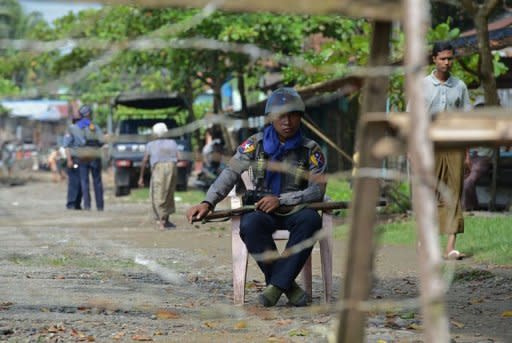Muslims trapped in ghetto of fear in Myanmar city
Barbed wire and armed troops guard the Muslim quarter of a violence-wracked city in western Myanmar, a virtual prison for the families that have inhabited its narrow streets for generations. The security forces outside the ghetto in the Rakhine state capital Sittwe are not there to stop its residents leaving -- although few dare to anyway -- but to protect them from Buddhist mobs after an outburst of sectarian hatred. In the nearby city centre, life has regained some semblance of normality since the authorities imposed a state of emergency in June in response to Buddhist-Muslim clashes that left dozens dead and tens of thousands homeless. But inside the tense enclave of Aung Mingalar, hundreds of families from the Rohingya Muslim minority group say they are living in fear for their lives. "Rakhines will attack us today," one man told AFP at Friday prayers last week. The same evening groups of Rakhine Buddhists -- who have also accused the Rohingya of attacks on their communities -- gathered outside the barriers, prompting troops to fire warning shots and sparking panic inside. On three separate days earlier in the week, hundreds of ethnic Rakhines -- sometimes led by Buddhist monks -- had marched near the perimeter demanding the "relocation" of Aung Mingalar. Their shouts were clearly audible by people within the ghetto, who could only imagine what was happening outside. "In my opinion, living in the Sahara desert in Africa would be better than living in this situation," said 28-year-old Mohamed Said, tears welling in his eyes. "We cannot suffer anymore. We have lost everything but our lives. We are human beings as well," he said. Between 3,000 and 8,000 people are thought to live in an area of roughly 0.5 square kilometres (0.2 square miles), where no traffic circulates and almost all shops have been shuttered. Supplies of food -- mainly rice -- are provided by the authorities and some benevolent Buddhist locals, forced to deliver aid discreetly for fear of fanning local resentments. But there is not enough to eat. Some Rohingya have dared to breach the barriers -- which vary from bamboo and barbed wire to simple security cordons -- hiding their faces under hoods to prevent people identifying them. But most people have not ventured outside in four months. "This bamboo fence is like a psychological barrier, symbolising the fear that separates the two worlds," said Chris Lewa, head of the Arakan Project, which campaigns for Rohingya rights. Calls are growing for the Muslim quarter to be moved. "If the Aung Mingalar quarter stays in the city centre, the problem will get worse," said Nya Na, a leader of a monk association. "I don't want the two communities to fight. It is risky for them to stay." The stateless Rohingya have long been considered by the United Nations to be one of the most persecuted minorities on the planet. Viewed as illegal immigrants from neighbouring Bangladesh by the Myanmar government and many Burmese -- who call them "Bengalis" -- they face tight restrictions on their movements and limited access to employment, education and public services. More than 50,000 Muslims and up to 10,000 Buddhists are thought to be displaced across Rakhine state, where people from both communities were forced to flee as mobs torched whole villages. Segregation, already imposed on many of the 800,000 Rohingya living in western Myanmar, has become widespread since the unrest, with many fearing the divide will become irreversible. Muslims have been left particularly deprived, with thousands living in squalid camps on the edge of Sittwe, separated from the Buddhist population and with scant provisions. Muslim men and women whose beards and headscarves were common sights just six months ago have largely disappeared from sight in the city centre. The segregation recalls South African apartheid in the 1980s, "but worse" because the Rohingya are unable to leave their camps, Lewa said. "Freedom of movement was always an issue for the Rohingya, but it is an extreme restriction now," said Sarnata Reynolds, of aid group Refugees International. "Unofficially there seems to be widespread agreement that the camps will likely be there for three years or more, and that it might be the beginning of a permanent segregation." The UN, which has been active in the region for decades, is more hopeful. "We are informed by the government that it is for the purposes of bringing the unrest under control, that this is a temporary separation, not a segregation," said UN country chief Ashok Nigam. But even if the camps are closed and the barbed wired surrounding Aung Mingalar taken down, the fear is that the distrust will endure between communities that once lived side-by-side as neighbours. "As long as Bengali people are here, there is fear, disharmony and anger. I wish they would stay away from here," said 60-year-old Buddhist San Win Phu, sheltering at a local monastery.




